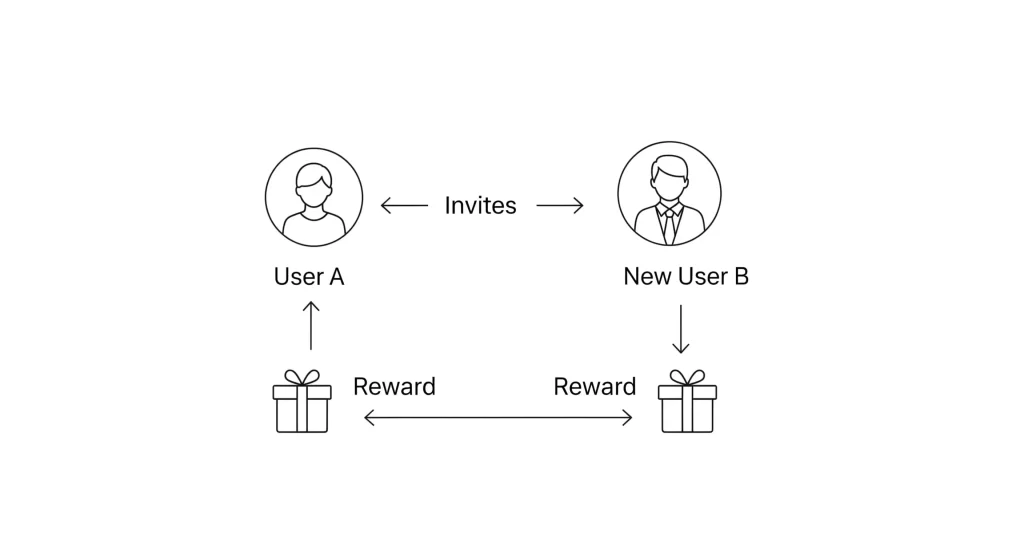The best way to understand the theory of viral loop is to see it in action. The most successful apps in the world didn’t just get lucky; they meticulously engineered systems where their users became their primary acquisition channel. These product led growth examples are the ultimate case studies in sustainable, scalable growth.
This guide will deconstruct 10 famous viral loop examples from top apps. We won’t just describe what they are; we’ll analyze why they work from a psychological perspective and provide a clear, technical framework for how you can replicate their core mechanics in your own app.
Table of Contents
Part 1: Incentivized Viral Loops
These loops operate on a clear value exchange. The user is offered a tangible reward for successfully referring a new user.
1. The Dropbox Viral Loop: Incentivized Storage
The Loop: Dropbox offered users a simple proposition: invite a friend, and if they sign up, both you and your friend get 500 MB of extra storage space, for free.
Why It Works: The reward (storage space) is directly tied to the core value of the product. More storage makes Dropbox more useful, creating a powerful motivation. The dual-sided nature makes the invitation feel like a genuine gift.
2. The Robinhood Viral Loop: The Free Stock Lottery
The Loop: Robinhood offered new users and their referrers a free stock, chosen randomly, with a small chance of it being a high-value stock like Apple.
Why It Works: This loop leverages the power of variable rewards. The “lottery” aspect creates excitement and intrigue that a simple cash bonus cannot match, gamifying the referral process.
3. The Uber Viral Loop: Give a Ride, Get a Ride
The Loop: A user could share a code that gave their friend their first ride for free. Once the friend took that ride, the original user would get a credit for their next ride.
Why It Works: This removes all friction from the invitation. The sender is offering their friend something of immediate, tangible value at no cost to themselves.

Part 2: Social & User-Generated Content (UGC) Loops
These loops are powered by users’ intrinsic desire to share their own creations and achievements.
4. The TikTok Viral Loop: The Ultimate Content Engine
The Loop: The entire TikTok platform is a viral loop. A user creates a video, and the app makes it incredibly easy to share that video on other platforms, complete with a prominent TikTok watermark.
Why It Works: It’s powered by creativity, self-expression, and social validation. Every shared video acts as a powerful, authentic advertisement for TikTok.
5. The Strava Viral Loop: The Fitness Status Symbol
The Loop: After a user completes a workout, Strava generates a visually appealing summary image with their route map and stats, perfectly formatted for sharing on social media.
Why It Works: This loop taps into pride and social signaling. Athletes are proud of their accomplishments, and the shared image acts as a badge of honor and a high-quality ad for Strava.
6. The Wordle Viral Loop: The Shareable Grid
The Loop: After completing the daily puzzle, users can share their results as a grid of green, yellow, and black squares, showing their journey to the solution without revealing the answer.
Why It Works: It creates a sense of shared community and friendly competition. The abstract grid is instantly recognizable and creates curiosity among non-users.
Part 3: Collaborative Viral Loops
These loops are built into the core utility of the product. To use the product effectively, you *must* invite others.
7. The Figma Viral Loop: The Multiplayer Design Tool
The Loop: To collaborate on a design file in real-time, a designer must share an invitation link with their colleagues.
Why It Works: The virality is not a feature; it *is* the product. The loop is driven by necessity and benefits from powerful network effects.
8. The Slack Viral Loop: Building the Workspace
The Loop: A new workspace is useless with only one member. The very first action a new user is prompted to take is to invite their teammates.
Why It Works: Like Figma, this loop is driven by necessity. The product’s value is zero with one user and increases exponentially with each new team member.
9. The Calendly Viral Loop: The Scheduling Handshake
The Loop: A user sets up their availability and shares their Calendly link with others to book a meeting.
Why It Works: Every time a user successfully uses the product, they expose a new potential user to its value, creating a subtle, one-sided viral loop.
10. The Notion Viral Loop: Shared Documents & Templates
The Loop: Users create and share documents, wikis, or templates with others via a public link.
Why It Works: This combines collaboration with UGC. A user shares a useful resource with a colleague, who then discovers the power of the Notion platform for themselves.

The Common Thread: Unbreakable Tracking
As you can see from these viral loop examples, they all have one thing in common, regardless of their mechanics: they absolutely depend on perfect, deterministic attribution. Whether you need to grant a reward, understand which content is popular, or simply reduce friction in a collaborative flow, you must be able to reliably connect a new user back to the specific link they came from.
This is what Tapp provides. It is the essential engine for any of these product led growth examples, giving you the confidence that your data is accurate and your loop is unbreakable.
Frequently Asked Questions (FAQ)
What is the difference between a viral loop and a growth loop?
The terms are often used interchangeably. A “viral loop” specifically refers to a loop where users bring in new users. A “growth loop” is a broader term for any self-reinforcing system that drives growth, which could also include loops that increase retention or monetization, not just acquisition.
Which type of viral loop is best to start with?
For most apps, an **incentivized loop** (like a simple referral program) is the easiest to implement and test first. It allows you to prove the mechanics of your tracking and sharing flow before building more complex, product-integrated loops like social or collaborative ones.
How do I know where to place the “share” prompt in my app?
Find the “moment of delight” or “aha!” moment in your user journey. This is the point where the user has just received maximum value from your app (e.g., after completing a level, finishing a task, or seeing a positive result). This is the point of highest emotional satisfaction and the perfect time to prompt a share.
Can B2B apps have viral loops?
Absolutely. Collaborative loops (like those used by Figma and Slack) are inherently B2B. Even incentivized loops can work well, offering rewards like account credits or a discount on the next month’s subscription instead of cash.
Conclusion
These successful viral loops are not accidents; they are meticulously engineered systems built on a deep understanding of user psychology and a rock-solid technical foundation. By studying these examples, you can identify the right type of loop for your app and begin the process of building your own sustainable growth engine.
The key takeaway is that you must start with the right foundation. Before you design the incentive or write the sharing copy, you must have a reliable attribution system in place.
Inspired by these examples? Start engineering your own viral loop on a foundation of perfect attribution. Sign up for your free Tapp account today.
To understand the core theory behind these examples, read our full Engineer’s Guide to Creating Viral Loops for App Growth.
